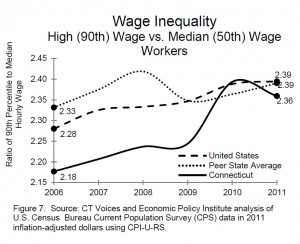Trying to reach the bottom rung of the economic ladder
Posted: July 25, 2013 Filed under: Employment, Income Leave a comment »
Rodney Moore of New Haven Family Alliance, speaking with participants in the Project Success program
A report out this week by researchers at Harvard and U.C. Berkeley found the chance that someone born into the bottom fifth of the economic ladder in Connecticut could rise to the top fifth is about 8%. For some young low-income people, even the bottom rung of that economic ladder feels out of reach. One program in New Haven is working to help them start that climb.
Listen to Craig LeMoult’s story here:
The New Haven Family Alliance runs a program called Project Success to help young people who don’t see a path for themselves to jobs in the regular economy. Economists say even with a regular job, climbing out of poverty is a challenge.
Conn. NAACP describes “urban Apartheid”
Posted: April 10, 2013 Filed under: Employment, General, Housing, Income Leave a comment »NAACP members in greater New Haven are calling on the federal and state government to re-examine the disparities between low-income people of color in urban neighborhoods and white people in the suburbs. The report, called “Urban Apartheid,” looks at disparities in areas like education, income, and housing.
You can hear Will Stone’s story on the report here:
NAACP Chapter President James Rawlings says the findings show that place matters. He means neighborhoods in and around New Haven where, for example, the poor are six times less likely to have access to transportation, which in turn affects their chances of employment. A quarter of African American men in the region were unemployed in 2011. Rawlings says it all comes back to the educational achievement gap, and he says the key is removing children from what he calls “unhealthy communities.”
“The transportation system isn’t there to support the children, libraries are not there to support the child, the family wrap-around services are not there to support the child,” he says.
The NAACP is recommending that affordable housing be placed in more suburban communities, where the air is cleaner and there’s less crime.
From luxury to foodstamps: One story of Conn.’s economic ladder
Posted: February 13, 2013 Filed under: Employment, Income Leave a comment »Some social service workers say they’re seeing more people coming to them for help who used to be on the rich end of Connecticut’s economic spectrum. That’s the case for Ken Mathis, who used to live in a 5,500 square foot house in New Canaan when he was partner at a number of top business consulting firms and technology companies. Today, he gets by with the help of food stamps and Medicaid. Here’s his story:
Have you seen similar stories of people’s path down Connecticut’s steep economic ladder? Let us know. What does their experience say about the state’s economic disparity? Coming up soon on “State of Disparity,” we’ll share stories of people at the bottom, trying to work their way up that ladder.
Nobel laureate Joseph Stiglitz: Inequality is holding back the recovery (Paul Krugman disagrees)
Posted: January 22, 2013 Filed under: Education, Employment, General, Income, Politics Leave a comment »The New York Times launched a new blog this week called The Great Divide, looking at inequality in the U.S. The blog is moderated by Joseph E. Stiglitz, a Nobel laureate in economics, a Columbia professor and a former chairman of the Council of Economic Advisers and chief economist for the World Bank. Stiglitz wrote the initial post in the blog, entitled “Inequality is holding back the recovery.”
“Politicians typically talk about rising inequality and the sluggish recovery as separate phenomena, when they are in fact intertwined,” Stiglitz writes. “Inequality stifles, restrains and holds back our growth.”
Stiglitz argues there are four major reasons inequality is squelching the recovery:
– The middle class is too weak to support the consumer spending necessary to drive growth
– The middle class is unable to invest in the future through education or starting/growing businesses
– The weak middle class holds back tax receipts needed for infrastructure, education, health, etc.
– Inequality leads to boom-and-bust cycles that make the economy more volatile and vulnerable
Stiglitz blames the economic policies of both the Obama and Bush administrations for making things worse.
“Instead of pouring money into the banks, we could have tried rebuilding the economy from the bottom up. We could have enabled homeowners who were ‘underwater’ — those who owe more money on their homes than the homes are worth — to get a fresh start, by writing down principal, in exchange for giving banks a share of the gains if and when home prices recovered. We could have recognized that when young people are jobless, their skills atrophy. We could have made sure that every young person was either in school, in a training program or on a job. Instead, we let youth unemployment rise to twice the national average. The children of the rich can stay in college or attend graduate school, without accumulating enormous debt, or take unpaid internships to beef up their résumés. Not so for those in the middle and bottom. We are sowing the seeds of ever more inequality in the coming years.”
He offers suggestions for President Obama’s second term.
“What’s needed is a comprehensive response that should include, at least, significant investments in education, a more progressive tax system and a tax on financial speculation.”
A lot to talk about here. Do you agree with Stiglitz’s arguments? Do you think inequality is holding us back from an economic recovery? What about his prescription for fixing it? Would education investment or a more progressive tax system make a difference?
Economist and New York Times columnist Paul Krugman (also a Nobel laureate) disagrees with him. In two responses to Stiglitz (Jan. 20 & Jan. 21), he says he’d love to blame slow growth on inequality. “But I couldn’t and can’t convince myself that the theory and evidence really support that view,” he writes in the second piece. “Inequality is a huge problem – but not for employment growth in 2013 or 2014.”
Report says wage and unemployment gap is increasing
Posted: August 30, 2012 Filed under: Employment, Income Leave a comment »The advocacy group Connecticut Voices for Children releases their jobs report every year around Labor Day. And the say this year’s report shows Connecticut is increasingly becoming a state of “haves” and “have nots”. The report says the middle income jobs, like manufacturing, that don’t necessarily require a four year degree, are disappearing, and being replaced by lower paying jobs in areas like healthcare, hotels and restaurants.
Listen to the story here:
“Probably the most striking thing we’ve seen is that CT’s middle class is being hollowed out and wealth is increasingly being concentrated among the state’s wealthiest citizens, says CVfC’s Kenny Feder. “Over the recent economic recession and recovery, the highest wage workers enjoyed wage growth 4 times that of median wage workers, while wages stagnated for low wage workers.”
This chart from the report illustrates his point:

A chart from the report showing how much more high income workers made than the median income level in Conn. (solid line)
While more of Connecticut’s jobs are paying less, there’s also more unemployment at the lower end of the economic spectrum. The unemployment disparities are most pronounced in the study when looking at race and ethnicity in the state. In 2011, more than 17% of Blacks and nearly 18 percent of Hispanics were unemployed, compared to just over 7% of Whites. And age makes a difference. The unemployment for younger people, the 16 to 24 year olds who are out looking for jobs, is over 18 percent, more than double the state average.
Connecticut Voices for Children is using their latest report to urge lawmakers to strengthen the state’s education system, as well as invest in job training programs and raise the state’s minimum wage.
Read the full report here.


Recent Comments